Bayer R.G. Mechanical Wear Fundamentals and Testing, Revised and Expanded
Подождите немного. Документ загружается.

17. P Kapsa, J Martin. Boundary lubricant films: A review. Trib Intl 15(1):37–41, 1982.
18. Roller Bearings, Vol. 60, Part I and Part II, Lubrication (Jul–Sept and Oct–Dec). Beacon, NY:
Texaco, Inc., 1974.
19. H Cheng. Fundamentals of elastohydrodynamic contact phenomena. In: N Suh, N Saka, eds.
Fundamentals of Tribology. Cambridge, MA: MIT Press, 1980, pp 1009–1048.
20. A de Gee, A Begelinger, G Salomon. Lubricated wear of steel point contacts – application of
the transition diagram. Proc Intl Wear Materials Conf ASME 534–540, 1983.
21. J Dominy. Some aspects of the design of high speed roller bearings. Trib Intl 14(3):139–146,
1981.
22. R Fein, F Villforth. Lubrication. Vol. 51. No. 6. Beacon, NY: Texaco Inc., 1965.
23. D Dowson. In: P Ku, ed., Concentrated Contacts: NASA, , SP-237, 1970.
24. J Martin, J Georges, G Meille. Boundary lubrication with dithiophospates: influence of lubrica-
tion of wear of the friction interface steel=cast iron. Proc Intl Conf Wear Materials ASME 289–
297, 1977.
25. A Singh, B Rooks, S Tobias. Factors affecting die wear. Wear 25(2):271–280, 1973.
26. E Rabinowicz. Friction and Wear of Materials. New York: John Wiley and Sons, 1965.
27. A Braun. Porous bearings. Trib Intl 15(5):235–242, 1982.
28. T Tallian. On competing failure modes in rolling contact. ASLE Trans 10(4):418–439, 1967.
29. F Bowden, D Tabor. Friction. Malibar, FL: Robert E. Krieger Pub.Co., 1982.
30. E Finkin. A theory for the effects of film thickness and normal load in the friction of thin films.
Lub J Tech ASME 7=69(551–556).
31. P Murti. Lubrication of finite porous journal bearings. Wear 26(1):95–104, 1973.
32. K Muller. Prediction of the occurrence of wear by friction force-displacement curves. Wear
34:439–448, 1975.
33. E Hsue, R Bayer. Tribiological properties of edge card connector single=tab interface. IEEE
Trans CHMT 12(2):206–214, 1989.
34. R Bayer. The influence of lubrication rate on wear behavior. Wear 35:35–40, 1975.
35. F Bowden, D Tabor. The Friction and Lubrication of Solids. Part I, Chapter V. New York:
Oxford Univ. Press, 1964, p 3.
Copyright 2004 by Marcel Dekker, Inc. All Rights Reserved.
7
Selection and Use of Wear Tests
From an engineering standpoint, the reason for performing a wear test is to provide
data that can be applied to a specific application, generally to increase life, reduce cost
and maintenance, and provide reliable performance. Frequently in the minds of the engi-
neer or designer, this is translated simply into selecting the best material for the design.
However, as will be discussed in Engineering Design for Wear; Second Edition, Revised
and Expanded, wear tests are used to provide additional engineering information as well.
For example, wear tests may be required to help identify the wear mode and wear equa-
tion associ ated with the application; to develop the necessary engineering relationships
among various design factors (e.g., shape, roughness, counterface properties, and wear);
to determine values of wear parameters associated with models; and to determine and
characterize transitions in wear behavior. All this may be summarized by saying that
wear tests are done to provide wear data of one type or another, not simply material
ranking.
From a designer’s standpoint, the primary need is to obtain wear data, preferably
without doing a wear test. Frequently as a result, the focus is initially on finding and util iz-
ing available wear data and not on developing or selecting a wear test to generate the
needed data. What has to be recognized in such an approach is that implicitly the selection
and use of wear data is equivalent to selecting and using a wear test. The data were
obtained from some test. As a result, the subject of wear testing is fundamentally equi-
valent to wear data selection and the points that will be developed regarding wear testing
can be applied to the selection of published wear data. Of course with the use of existing
data, the cost and the time associated with doing a test are eliminated.
As discussed in Part A Fundamentals, the nature of wear is complex. There are sev-
eral mechanisms for wear, each of which is sensitive to a wide number of parameters but
not necessarily to the same ones nor in the same way. There is no single, unique, universal
parameter, which can be used to characterize wear behavior. As a consequence, there is no
single, universal test for wear. Rather, this complex nature of wear results in the need for a
variety of wear tests, each addressing one particular aspect of wear or wear situations. The
large number of wear tests and apparatuses that can be found in the literature serves to
illustrate this point (1–6). Another point that needs to be recognized from the information
about wear presented in Part A is that wear testing does not define or measure a funda-
mental or intrinsic material property, like modulus or strength. In that sense, it is not a
material’s test. Rather, it measu res or characterizes a material’s response to or behavior
in a system environment. Basically, this is because wear is not a materials property but
a system property. Materials can behave differently in different wear situations, as has
been discussed and illustrated previously. As a consequence, different wear tests tend to
provide different rankings of materials.
Copyright 2004 by Marcel Dekker, Inc. All Rights Reserved.
To the engineer this situation begs the question, ‘‘Wha t is the appropriate test for the
application at hand?’’ Hence, wear test selection and use is an appropriate and key aspect
in the overall consideration of wear testing. Furthermore, the answer to the question is to
select the wear test which best simulates the actual wear situation. The need to simulate the
application in the wear test is pointed out again and again in the literature (2–5, 7–13).
The key to the relevance of any wear test to an application lies in the degree to which
the application is simulated in the test. There are several levels of simulation, which are
significant to the development, selection, and use of wear tests. The most fundamental
or basic level of simulation is in terms of the general nature of the wear situation. For
example, this level of simulation is concerned with whether both the application and the
test represent a rolling, sliding, or impact wear situation; unlubricated or lubricated wear;
two- or three-body abrasi on; erosion by solid particles or liquids; etc. This level of
simulation can be termed as first-order simulation.
The next level of simulation (or second-order simulation) is related to the values of
key parameters of the wearing system. Two elements are involved in this: the first is
the identification of the significant parameters, and the second is the identification of
the appropriate range that is needed for this parameter in the test in order to provide simu-
lation. Examples of elements to be considered in this respect are load, speed, stress, and
temperature. Other elements that have to be considered at this level are counterface
parameters, nature of the third-bodies involved, amount and type of lubrication, and
unidirectional or reversing sliding. However, the list is not limited to these as any aspect
or parameter, which can influence wear or friction is a candidate for consideration at this
level of simulation.
Third-order simulation, the next level, is essentially replicating the actual wear situa-
tion. All parameters and features are similar, if not identical, to those in the application.
At this level of simulation, the wear tester is often very similar to the actual device and may
be an instrumented version of the device or a replica of a portion of the overall machine or
mechanism. Wear testers at this level of simulation may be called wear robots, to contrast
them to the type of apparatuses used in first- and second-order simulation, which are gen-
erally laboratory type devices. The differences between thir d-order simulation and actual
machine testing or field-testing generally lie in the area of control and data acquisition.
At this level of simulation, testing conditions are generally more controlled and wear
measurements are more frequent and refined than in field-testing.
The level of simulation that is requ ired in a wear test depends on the purpose of the
wear test. If the intent of the test is to provide only general type of information, then first-
order simulation is adequate. Tests to understand the general nature of wear occurring in
a given type of situation, to provide broad ranking of material groups, to identify major
factors effecting wear and to identify general trends, are examples of this type of purpose.
When more specific information is required, such as the need to rank or select materials
for a given application, to project wear performance of a given design, or to determine
the value of a specific design parameter required for optimum performance, second- or
third-order simulation is required. The need for specific information of this type is gener-
ally characteristic of engineering applications and consequently wear tests generally done
for engineering purposes will require this higher degree of simulation. Tests associated
with more fundamental or research studies generally have only first-o rder simulation,
when compared to applications. Tests used by material developers tend to provide
first-order simulation for most applications.
Providing second-order sim ulation assumes that the major factors influencing the
wear have been identified. That identification might in itself require some testing, possibly
Copyright 2004 by Marcel Dekker, Inc. All Rights Reserved.
involving first-order simulation, or might be available from experience or published infor-
mation. The thoroughness to which this is done influences the degree of risk associated
with the use of the data from the test. Another way of stating this is that the correlation
expected between the test an d actual performance is controlled by this element. The less
thorough this is done, the higher the risk associated with projecting the actual perfor-
mance or the lower the anticipated correlation. With the use of third-order simulation, risk
is minimized and improved correlation with actual performance can be obtained.
For most engineering situations, third-order sim ulation is not required to provide
the useful and specific information desired. Second-order simulation is usually adequate,
provided the parameters influencing the wear are correctly identified and understood. That
is the key. Frequently though, tests that are basically representative of third-order simula-
tion are used as a result of pragmatic considerations. In certain cases, it may not be prac-
tical or desirable to spend the time to identify the major factors in the wear situation or to
develop an apparatus that provides the adequate simulation and control over these. It may
be easier to instrument the device itself (or a replica of the device) and use it as a wear
robot to provide data under actual use conditions. Because this approach tends to include
all interactions, it reduces risk and enhances correlation. This type of test does have some
negative aspects, though. While time and effort are usually saved by avoiding tests to iden-
tify significant parameters, these robot-type tests tend to be more lengthy and involved
than those associated with second-order simulation. Also, robot tests generally do not
directly provide information about fundamental relationships. However, robot tests do
provide information regarding parameters, which, while not basic, may be more relevant
and significant to the application.
The choice of the apparatus used is a key part in any simulation. While this is the
case, there are other elements, which are equally as important to the simulation and have
to be considered. For example, the environment in which the wear test is done, the proper-
ties of the counterface(s), and the characteristics of the wearing media (particularly in ero-
sion and abrasion testing) are equally as important. In addition to simulation, there are
other testing and tester aspects which are also important to the proper conduction of a
wear test. Sample preparation, data recording, wear measurement technique, and analysis
of the data are examples. Variations in these elements are generally sources for the scatter
in test data. While procedures for these elements are often specified for standard tests, they
may not be adequate. It is also necessary to recognize the primary purpose of the standard
test. It may not be wear but friction or lubricant evaluation. As a result, it is necessary to
review these procedures and perhaps modify them for use as a wear test. These elements,
along with simulation, will be discussed in greater detail in subsequent sections.
Because of the need to simulate and the complex nature of wear, most laboratories
associated with wear testing have a variety of test apparatus and procedures that are used,
often with modifications, to address specific problems (2,10,14–17). The particular comple-
ment of test apparatus that a laboratory has and the procedures used generally reflect the
nature of the industry that the laboratory supports and the purpose for which the testing is
done. For example, a laboratory associated with the wear of office and data processing
equipment typically utilizes different apparatuses than a laboratory associated with the
wear of airframes (18,19). Similarly, both will likely have different tests an d procedures
than a laboratory supporting a light manufacturing operation (20–24).
Laboratories associated with material suppliers and developers tend to form a
unique category that tends to be somewhat different than laboratories associated with
design. Generally, laboratories associated with material development have testers and pro-
cedures, which allow them to differentiate material behavior quickly for some broad area
Copyright 2004 by Marcel Dekker, Inc. All Rights Reserved.
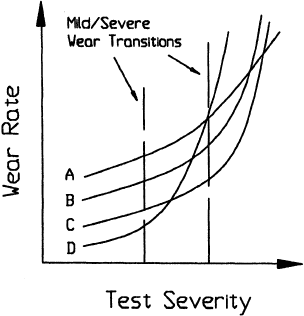
of application and which are appropriate for one particular class or type of material. For
example, tests used in laboratories concerned with the development of hard, bulk materi-
als, such as tool steels or ceramics, are generally not the same as those used in laboratories
associated with the development of coatings or plastics (3–5,25,26). High speeds, high
stress, and, in the case of ceramics, high temperature, are typical features of test s used
for the former; for the latter, milder tests conditions and different durations are generally
required to differentiate between materials. The harsher conditions used for tool steels or
ceramics would result in such large and more severe wear for the other two types of mate-
rials that differences in performance would be less apparent. Conceptually this is illu-
strated in Fig. 7.1, where wear rate is plotted as a function of test severity or harshness.
Above the mild=severe wear transition, there is less difference in rate than below the tran-
sition. Transition points can also vary with mate rial. As a result, movement of the transi-
tion point can also confound the comparison as well, as is illustrated in the same figure.
The situation with coatings is shown in Fig. 7.2, where wear depth is plotted as a function
of test duration. As can be seen, if the test results in wear-through of the coating, the
ability to differentiate is again reduced.
The milder conditions required for plastics and coatings evaluations, as compared to
tool steels and ceramics evaluations, also reflect the differences between the typical appli-
cations for these types of materials. In effect, this demon strates the requirement of simula-
tion. The situations illustrated in Figs. 7.1 and 7.2 indicate the source of some of
the problems that can occur as a result of lack of adequate simulation, namely improper
ranking and selection of materials.
A common feature of most of the tests used by materials-oriented laboratories is the
tendency to focus simply on providing material rankings, rather than on the determination
of parameters needed for wear prediction or selec tion of an over-all design (25–34). These
latter aspects tend to be found in the tests used by the laboratories associated with the
design and development of new equipment and the development of design information.
Examples of this type of data might be specific values of wear parameters to be used in
conjunction with a model (35), the determination of transition points (36,37) and the influ-
ence of design parameters other than material selection on system wear (38,39). In tests
used for material ranking purposes, it is often the practice to use the amount of wear gen-
erated after a particular amount of time, number of revolutions, abrasive consumed, etc.,
Figure 7.1 The effect of test severity on relative wear behavior.
Copyright 2004 by Marcel Dekker, Inc. All Rights Reserved.
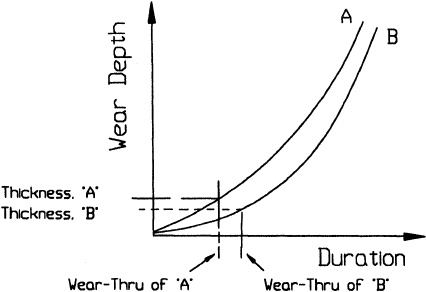
to provide the ranking. In tests used to provide more design-oriented data, tests involving
the generation of a wear curve, that is, a plot of wear or wear rate vs. usage or exposure,
are frequent ly desirable or needed. In general, the wear curve provides more information
than a single point an d may be needed to differentiate behavior, particularly when the
possibility of different wear modes exists with different materials.
The need to simulate the application in the wear test and the confounding influences
of purpose and materials on that simulation can have significant effect on the testing pro-
cedures and equipment used. One way of illustrating this is to consider the wear tests and
approaches associated with three different laboratories that have been published in the lit-
erature. The first labo ratory is associated with the wear of components found in business
machines and peripheral computer equipment (18,40–42). The next is associated with the
wear of components of light manufacturing equipment in a chemically oriented industry
(20–24). The third is concerned with the wear of airframe elements (19). Figures 7.3,
7.4, and 7.5 contain illustr ations of the testers used by these laboratories, along with a
description of the data generated in the tests and the purpose of the test. An examination
of these figures shows that the apparatus and pro cedures are quite different for each of
the laboratories. This is a consequence of the need to simulate the significantly different
applications as well as difference in the purposes of the wear tests.
In the first laboratory, the focus was to select a design which woul d achieve a given
life and therefore the tests were used to provide more general engineering information, not
simple material selection. The tests were used to develop engineer ing models for wear,
determine values of parameters associated with those models (including material para-
meters), and investigate the influence of other design parameters on the wear, such as
radius or shape, thickness of coatings or layers, roughness, edge conditions, and align-
ment. Once a model was developed, an appropriate test to evaluate and compare materials
was usually identified, since material selection is always a part of a design approach.
The wear situations encountered in this laboratory included: sliding, rolling,
impact, and mixtures of these motions; metal=metal, metal=polymer, polymer=polymer
interfaces; wear both by and of paper, inks, ribbons, and magnetic media; some form
of boundary or dry lubrication; generally mild environmental conditions, e.g., room tem-
perature or near roo m temperature and normal atmosphere. Normally, only mild wear
behavior could be accepted in these applications. While in most of the applications loads
tended to be small (e.g., order of pounds or less), stress levels could be high because of
Figure 7.2 The effect of coating wear-through on relative wear performance.
Copyright 2004 by Marcel Dekker, Inc. All Rights Reserved.
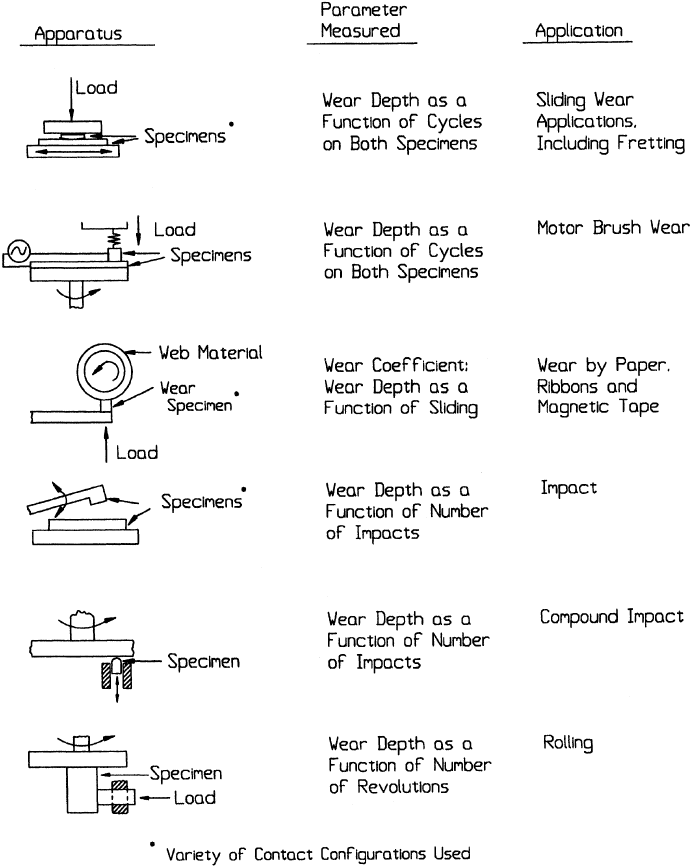
small contact areas in the applications. How ever, since long life generally requires the
stress level to be well below the elastic limits of the materials, stresses in the applications
were generally a fraction of the elastic limits of the materials used.
Often the loads in these applications were generated from kinematic conditions or
were time varying, rather than a constant load supplied by a dead-weight or spring. Parts
were relatively small a nd contacts were generally nonconforming. Performance was typi-
cally affected by small amounts of wear. Changes in the range from 0.001 to 0.010 in.
Figure 7.3 Wear tests used for computer peripheral applications. The tests were used to develop
wear models, to determine wear coefficients, to investigate the effects of different parameters, the
selection of design parameters, and to rank materials.
Copyright 2004 by Marcel Dekker, Inc. All Rights Reserved.
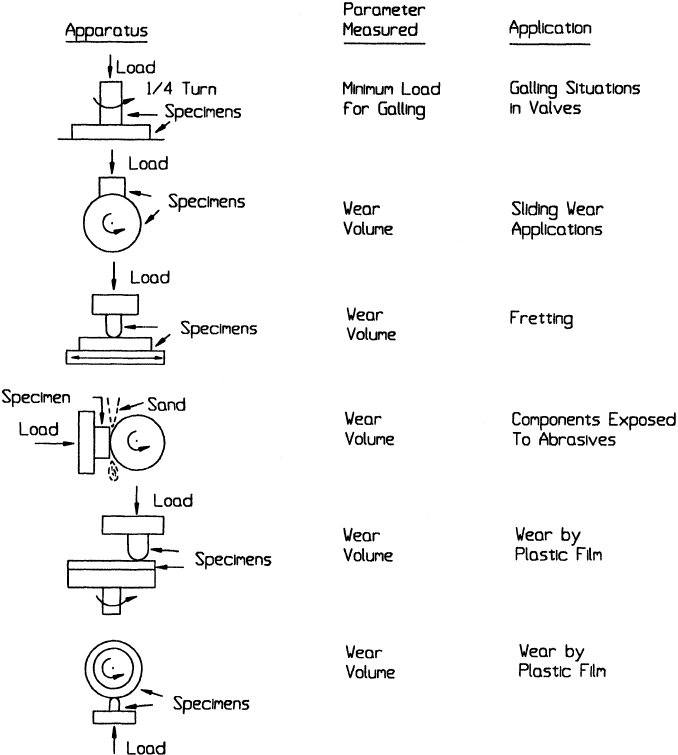
(sometimes less) of a critical dimension frequently resulted in functional failure in the
applications.
A review of the apparatuses used by this laboratory and their features, shown in
Fig. 7.3, indicate that these apparatuses have the same general features of the applications.
The apparatuses accommodate small spec imens, provide light loads and different motions,
accommodate different materials, and generally involve nonconforming contacts. The
nature of these wear situations has typically resulted in the development of unique
apparatuses and test methods in order to simulate these situa tions and to provide the
needed da ta. The impact wear apparatuses, the drum tester, the C-ring configuration,
and the configuration used for elastomer drive rolls (Fig. 7.3), are examples of some of
the unique test configurations used. Since initial wear cannot be ignored in applications
which are sensitive to small amounts of wear, many of the tests involve the development
Figure 7.4 Wear tests used for manufacturing equipment in a chemically oriented industry. The
tests were used to rank materials in terms of their resistance to different types of wear. Often, several
tests were combined into a screening procedure of the selection of materials for a given application.
Copyright 2004 by Marcel Dekker, Inc. All Rights Reserved.
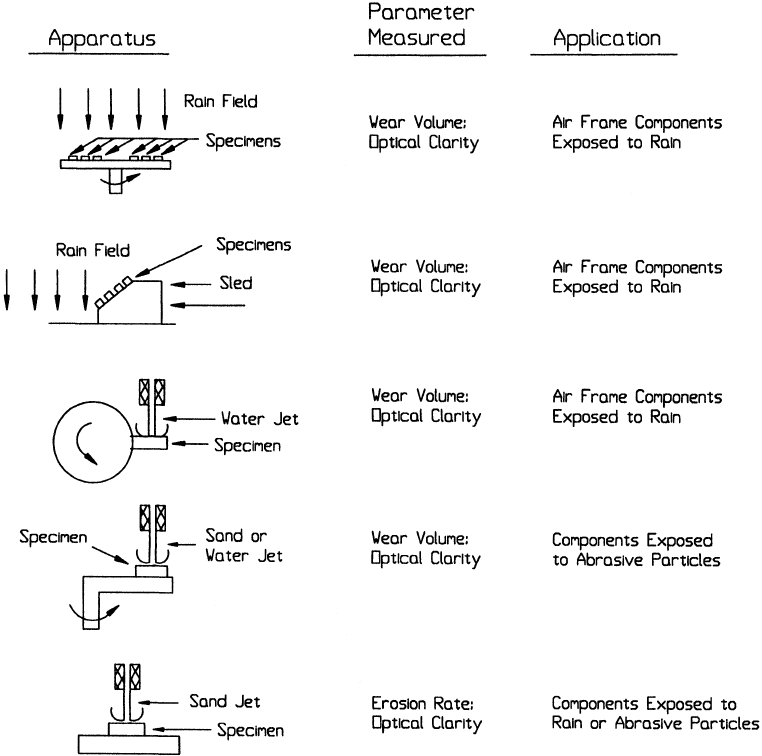
of wear curves rather than simply utilizing data after a stable wear situation is achieved.
An illustration of this is the procedure employed with the ball=plane tester used for sliding
wear. In this case, a wear curve was developed to determine the exponent associated with
different wear modes as well as the determination of a material wear factor (43,44). This
method is illustrated in Fig. 7.6.
In order to establish a more complete engineering approach, many of the tests and tes-
ters were developed or selected so that the design parameters other than material
selection could be evaluated and to provide the basis for the development of engineering
models. Examples of this are the approaches used for impact wear (42,45,46), rolling=sliding
wear (41), the abrasive wear of a magnetic sensor (47), and C-ring wear (48). In these
cases testers were developed in which the effects of geometry, loading, and other design
Figure 7.5 Tests used by a laboratory concerned with the selection and development of materials
for use on airframes, including components that had to be optically transparent. The tests were
used to rank materials, to determine the effects of different parameters, and to investigate wear
mechanisms.
Copyright 2004 by Marcel Dekker, Inc. All Rights Reserved.
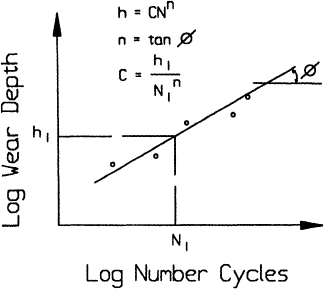
factors could be evaluated as well providing a capability for evaluating different materi-
als. Because of the complex ity of simulating some of the situations, many studies were
performed utilizing robots rather than developing specific testers; in some cases,
both were used to varying degrees. The wear of electroerosion print elements (49),
type carriers (50), print cartridges (51), and band=platen interfaces (Fig. 4.46) are
examples of situations for which robots were used extensively in this laboratory.
In contrast to this situation, the focus in the other two laboratories was to maximize
the machine or component life by selection of the optimum material or mate rial pairs.
Consequently, testing was primarily associated with material ranking. The thrust was to
develop a test procedure that simulated the application and allowed differentiation of
materials in a reasonable length of time. The test was then used to evaluate a matrix of
materials or material pairs for the application. A higher degree of simulation was
employed than is typical of simple material testing. Both laboratories generally establish
a second-order simulation in their tests.
In the second laboratory, that is the laboratory supporting a chemically oriented
light manufacturing operation, many of the wear situations were more representative of
classical contact situations, found in bearings, gears, and cams, than those encountered
in the first laboratory. Since hostile environments frequently limit the choice of materials
in chemical environments, the approach in this laboratory was generally to modif y a stan-
dard tester and test methods to account for the specific conditions of the application,
rather than to develop unique testers or test methods. This point is evident from examina-
tion of Fig. 7.4, which contains a summary of the tests used an d the applications to which
they are applied. In complex wear situations in which several distinct wear modes are pre-
sent, perhaps in different regions of the part, this laboratory tended to utilize a series of
tests, each focused on a particular mode, to provide a full evaluation (52). This is an
approach used in many laboratories (14,53,54).
While the third laboratory, that is the laboratory supporting airframe applications,
also focused on material selection, significantly different test apparatuses were required as
a result of the differences in the wear situations encountered. The primary concerns were
with the wear produced by high-speed motion through the atmosphere. Solid particle
erosion due to air-borne dirt, sand, etc. was one concern, others were the effects of rain
drop impingement and cavitation. The apparatuses developed and used for these types
Figure 7.6 Example of a wear curve and the data obtained from the ball-plane test for sliding wear
used in addressing wear concerns in computer peripheral applications.
Copyright 2004 by Marcel Dekker, Inc. All Rights Reserved.
